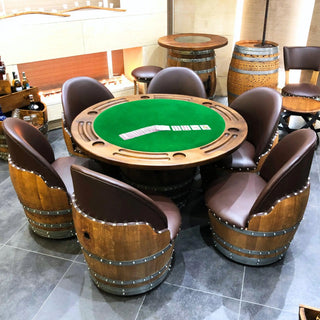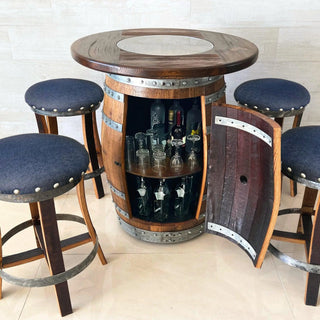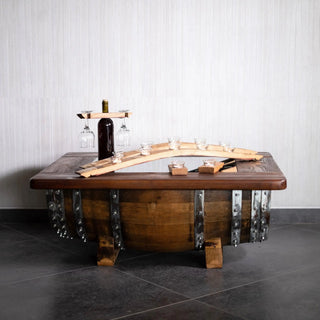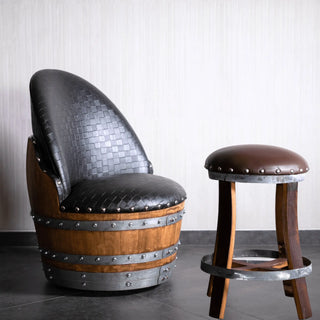Varnish vs. Oil Finish: What Makes Oak Barrels Last Longer Outdoors?
If you’ve ever owned an oak barrel—whether it’s a fire pit, a patio table, or a planter—you’ve probably fallen in love with that warm, rustic charm. There’s something about the texture of real oak and the way it glows in the afternoon sun that just makes a space feel alive.
But here’s the thing about nature: it always tries to take back what’s hers. Leave a barrel outside too long without protection, and it starts to lose its sparkle. The staves fade to a dull gray, the hoops loosen, and before you know it, your once-beautiful barrel looks like it survived a storm or two (and not in the good, “vintage character” kind of way).
So here’s the million-dollar question every barrel lover eventually asks:
Should I use varnish or oil to make my oak barrel last longer outdoors?
After restoring more barrels than I can count—and watching plenty of them age gracefully in the sun—I’ve come to think of this as more than just a technical question. It’s a personality test for your furniture.
Let’s Be Honest: Oak Has Feelings Too
Alright, not literally, but oak is alive. Even after it’s been turned into furniture, it still breathes, shifts, and reacts to the weather around it.
When the air gets dry, oak shrinks. When it rains, it swells. That natural movement is part of its charm—but it’s also what can cause cracks, gaps, or loose hoops if it’s not protected properly.
And that’s where the battle begins: Varnish vs. Oil.
One sits on top like armor. The other seeps in like moisturizer. Both have their fans. Both can be beautiful. But one might fit your lifestyle better.
Varnish: The Protective Armor
Think of varnish as the tough older brother of the finishing world. It’s the kind of finish that says, “Go ahead, rain—see if I care.”
A good varnish—especially marine-grade—forms a hard shell over the oak, sealing it from moisture, sunlight, and wear. It’s like wrapping your barrel in an invisible force field.
Why people love it:
- Crazy durable. Once it’s on, it stays on. Rain, sun, cold—no problem.
- Brings out rich depth. The color deepens beautifully, especially on wine barrel furniture where the grain already tells a story.
- Low maintenance. One or two good coats, and you’re good for months, sometimes years.
Why some don’t:
- It can crack. Oak moves, varnish doesn’t. When temperatures swing, you might see hairline splits.
- Touch-ups are a pain. Once it starts peeling, you’ll need to sand the whole thing down and start fresh.
- Sometimes it’s too shiny. Personally, I avoid high-gloss finishes—they can make a handcrafted piece look factory-made. A soft satin is much more forgiving and elegant.
If you want a set-it-and-forget-it kind of finish—like for a barrel coffee table on a sunny patio—varnish might be your guy.
Oil: The Gentle Soul
If varnish is armor, oil is therapy. It doesn’t seal the oak off from the world—it partners with it.
Oils like tung oil or Danish oil soak deep into the wood’s fibers, feeding and strengthening them from within. Instead of building a hard shell, oil creates a flexible, natural barrier that breathes with the wood.
Why people love it:
- Natural, soft feel. You can still feel the grain under your fingers. It’s warm, organic, alive.
- Easy upkeep. If it starts to dull, just wipe on another coat—no sanding, no drama.
- No cracking or peeling. Oil moves with the wood, so it ages gracefully.
Why some don’t:
- You have to reapply. Usually every few months. (But honestly, it’s therapeutic—I make a coffee, put on music, and it’s a vibe.)
- Less shine. If you like that glossy “wet” look, oil might feel too understated.
- Takes time to dry. It’s not for those who want instant gratification.
Oil finishes remind me of slow Sundays. The smell, the gentle rubbing, the way the color deepens like a fine wine. There’s a kind of peace in it.
So Which One Wins?
Let’s call it what it is—there’s no universal winner here. It depends on your piece and how much time you want to spend with it.
|
Category |
Varnish |
Oil Finish |
|
Look |
Glossy or satin sheen |
Natural, matte, warm |
|
Feel |
Smooth, sealed surface |
Textured, organic touch |
|
Protection |
Strong surface barrier |
Deep wood nourishment |
|
Maintenance |
Yearly or bi-yearly |
Every 3–6 months |
|
Reapplication |
Requires sanding |
Just wipe and refresh |
|
Best For |
Bar tops, tables, heavy exposure |
Planters, accents, softer weather |
If your oak barrel furniture lives outside year-round—especially under direct sun—varnish is your best bet. It’s the bodyguard your barrel deserves.
But if your barrel sits under a covered patio or porch, and you don’t mind a little routine love—oil is the choice that ages beautifully.
Personally? I cheat. I use both.
My “Best of Both Worlds” Trick
This one’s from years of trial, error, and one too many barrels that didn’t survive the summer.
- Sand the surface lightly. Just enough to open up the grain.
- Apply one coat of tung oil. Let it soak in overnight—it feeds the oak from the inside.
- Finish with a thin coat of marine varnish. That locks in the moisture while still letting the wood breathe a little.
It’s a hybrid method—oil for heart, varnish for armor. My outdoor wine barrel bar has sat through rain, sun, and even snow with this combo, and it’s still glowing like a glass of aged bourbon.
Bonus Tips from the Workshop
- Keep your barrels lifted off the ground with small rubber feet or wood blocks—water pooling underneath is a finish killer.
- Avoid direct sprinklers or hose sprays. Water sitting on the surface breaks down finishes faster than anything.
- Clean with a damp cloth, not soap. Soap strips the oils out.
- Touch it up often. Don’t wait until it looks dull—give it a quick refresh before it begs for one.
The difference between a good finish and a great one is consistency. Your barrel doesn’t need constant work—it just needs to know you care.
Our Links
- Explore our full line of outdoor oak barrel furniture and patio sets built to last.
- Learn how our craftsmen hand-restore wine and whiskey barrels into timeless furniture.
- Browse our collection of reclaimed oak barrel tables, bars, and planters for every space.
Other Resources to Check Out!
- Fine Woodworking: Outdoor Finishes That Endure the Elements
- The Cooper’s Journal: Preserving Authentic Oak Barrels
- Popular Woodworking: Oil Finishes vs. Sealants — The Honest Comparison
There’s something special about walking outside on a warm evening and seeing that soft oak glow under the sunset—the light catching on every curve of the barrel. When it’s protected right, oak doesn’t just survive outdoors—it thrives.
So whether you’re the “once-a-year varnish” type or the “slow-and-steady oil” kind, remember this: taking care of oak is less about maintenance and more about respect. Every barrel deserves that kind of love.
And if you do it right, you’ll still be admiring that same piece years from now, with a glass in hand and a quiet smile, thinking… yep, totally worth it.
Disclaimer
This guide is written for informational and educational purposes only. The techniques, products, and preferences shared here come from real woodworking experience and restoration practice. Always use protective gear, proper ventilation, and test any product on a small section before full application.
Oak Wood Wine Barrels is not liable for injuries, material damage, or undesired outcomes resulting from DIY restoration. Product availability, finishes, and protective coatings may evolve as our craftsmanship improves.
For expert help, professional refinishing, or to explore handcrafted outdoor-ready oak barrel furniture, visit OBARREL.COM — where every barrel gets a second life, one coat at a time.




